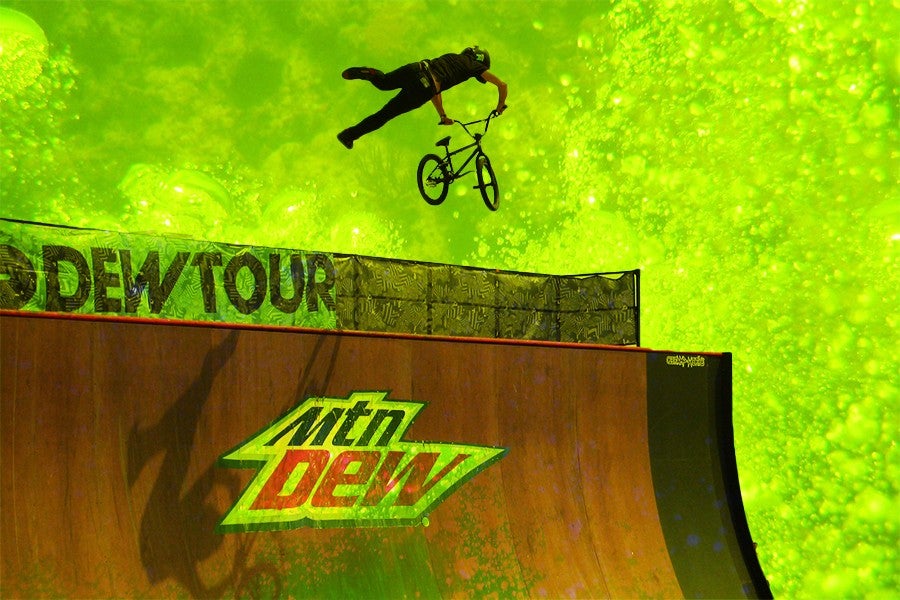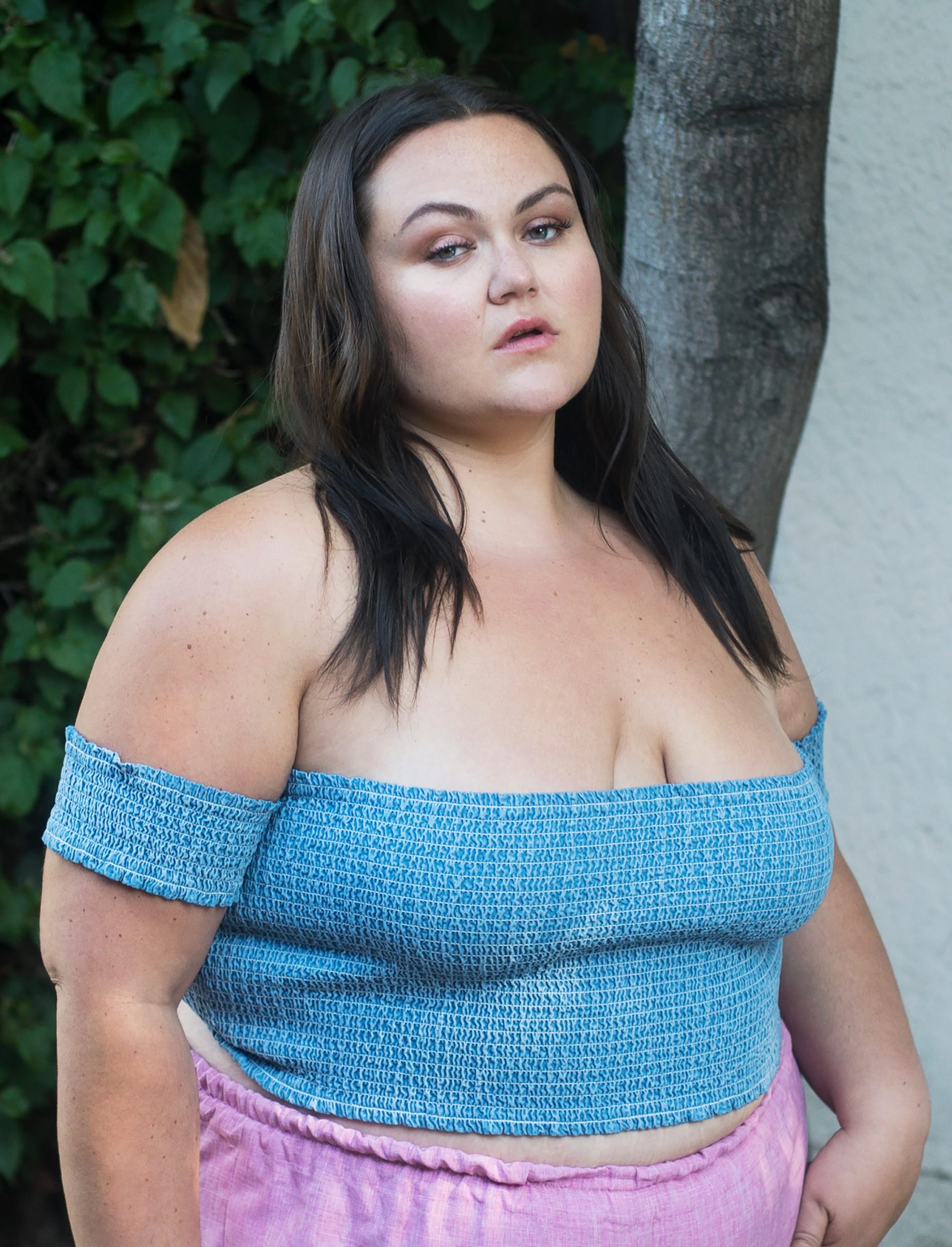You’d be hard-pressed to find a soda more extreme than Mountain Dew. It’s kinetic. It’s raw. It’s daring. Guzzled by risk-takers, daredevils and mavericks who break rules and land on their feet no matter what hurdles they face, Mountain Dew is the ultimate beverage of unruly masculinity.
Mountain Dew is bro.
At least, that’s the image they sell to men — men who drink it up.
In my boyfriend’s favorite Mountain Dew ad from 2000, the one he recalls as the most influential to him as a tween, the beverage literally becomes a bullet that breaks windows and burns holes in chain-link fences before seamlessly landing in a skater’s hand mid-trick.
According to him, those ads really did make him want to “Do the Dew.”
“I always loved the ads. They made me feel like I could do those same stunts. And when I’d go to the X-Games, there were ads and samples everywhere,” he tells me.
I began wondering about Mountain Dew’s bro-y identity long before I even met him, but I did notice an empty bottle of it in his apartment just a few nights ago. He also loves skateboarding, so I guess it makes sense. Lots of drinks have long been marketed to athletes, but Mountain Dew, with its weirdly unknowable nature and chartreuse color, has always catered to unconventional athletes — the rowdy skaters, rollerbladers and BMX racers of the world.
This strategy has worked. Mountain Dew holds an 80 percent market share in the citrus soda category. The only comparable beverages it trails in sales are Pepsi and Coke. More interesting still, only about 20 percent of its customers are responsible for 70 percent of all the Mountain Dew sold, meaning its market is niche, cultish even. Most of its fanbase are men in their 20s (like my boyfriend) — extreme as fuck men, like the ones Harold and Kumar troll in this scene from the original White Castle movie:
In general, Mountain Dew fans tend to live in the South or Midwest, though it’s most popular somewhere in between (Kentucky) and was born in Tennessee (which, as this Appalachian writer shares, means plenty of ostracization when these fans move to either coast to pursue careers in fields that don’t involve wheels or boards). Although most people don’t know what Mountain Dew actually refers to, given it’s not a cola or a specifically fruit-derived drink like Orange Crush or lemon-lime Sprite, the term isn’t arbitrary. Irish and Scottish immigrants who moved to the Appalachian region to mine coal called their mixers for moonshine, off-market bourbon and whiskey, “Mountain Dew.” Barney and Ally Hartman started bottling their Mountain Dew in the 1930s and marketing it as whiskey’s best friend, meaning it’s had a pretty manly ad strategy from its inception.
Even today it reportedly remains a staple among Appalachian workers, as Sarah Baird writes in her Eater story: “Coal miners in Appalachia rely on the drink’s caffeine to stay alert in a dangerous job. Many locals get water from unreliable wells and figure that, if they’re buying bottled water anyway, then they might as well buy soda.” (This cultural habit is one of the reasons why “Mountain Dew Mouth” has become synonymous with the region’s dental conditions.)
About that legendary Mountain Dew caffeine fix: Just one 12-ounce can has 55 milligrams of caffeine, meaning it has about 50 percent more caffeine than a can of coke. It would’ve had even more if it weren’t for physics, at least per Mental Floss:
“At one point during the early formulations of today’s popular version, it was amped up to an even greater degree. Tip Corporation executive Hugh Slagle reminisced that one prototype recipe ‘had so much caffeine in it that when bottled, the caffeine crystallized forming what looked like ‘slivers of ice or glass.’”
Mountain Dew sold to Pepsi in 1964. Its first ad was free of all the extreme sports with which it would become synonymous, but it was still notably masculine and “rough.”
Skaters and “fringe sports” such as skateboarding started appearing in the ads in the 1980s. These skaters were cool. In fact, they were “Country Cool,” the brand’s official slogan at the time:
It wasn’t until the early 1990s, however, that Mountain Dew officially went from a country brand focused on young bros frolicking in the outdoors to an action sports brand, which solidified its bro-tastic, skydiving, bold-as-fuck identity as we know it today:
All of this action-sports history was captured perfectly by Street & Smith’s SportsBusiness Journal back in 2013:
Bill Bruce [BBDO’s former chief creative officer]: When I came onboard, Seattle, as far as music, was blowing up with Nirvana and Soundgarden. There was a rebellion going on. MTV was playing some stuff from different athletic worlds. What jumped out at me was the idea of people just pushing themselves.
Dave Burwick (former Mountain Dew manager and later PepsiCo CMO): He didn’t pick any sport in particular. We did everything from street luge to BASE jumping. … There was [even] a “Learn to Ride” program. When first-time snowboarders came down the mountain, we handed them a Mountain Dew. We were linking that first exhilarating experience on a snowboard with our product.
John Galloway (former Mountain Dew brand manager and head of Pepsi’s sports division): I still remember the first Winter X Games. Each of us [sponsors] were assigned a 10-foot-by-10-foot booth space by ESPN. We got up there and said, “This is not us.” We sent our folks down to L.A. to get a speaker system to blow out this tent. We did a Mountain Dew slam race with people slamming Mountain Dew. We were seen as pretty rebellious.
When not focused on sports, Mountain Dew still choses brand ambassadors known for their badass physicality and fighting abilities — a la Steven Seagal and more recently, Chuck Norris:
Looking to have it both ways, however, a couple years ago, Mountain Dew made a “Black Label” option, which Ad Week mistook as “classy” and the New York Post considered “hipster,” despite how obviously bro such an offering is, resembling both a Monster Energy Drink and a Mike’s Hard Lemonade. “With a can like this, you’ll love to show it off,” the first actor in the commercial promises.
Despite the push for class, the ad plays to the same audience of bros and bro-hoes already obsessed with Monster and the Monster merch they get from redeeming their little green tabs.
To quote, well, myself:
“Bro-hoes… go to the desert and ride. They love Rockstar. And Monster. And Red Bull. And likely wear each brand’s apparel. They have gauge earrings and still swear by the cultural significance of Happy Bunny. They roll blunts and tan while their dads or boyfriends — or sometimes their dads and boyfriends together — work on cars. They ask questions about horsepower like they give a fuck and have dated at least one opiate addict in their young lives.”
(I really should’ve included Mountain Dew in this description, too.)
But even though Mountain Dew’s direct relationship to its audience means its branded content and overall identity is stronger than ever, not all of its old-school collaborators still stand by it.
“I decided to leave Mountain Dew because I wanted to make healthier choices,” pro skater P-Rod (aka Paul Rodriguez) announced last year when departing the company to promote Villager, the coconut water brand he co-owns.
“I want to skateboard forever. And I want to put stuff in my body that’s going to help me accomplish that goal. So being a part of starting Villager is just an extension of where my mind-state is at. And I think we all came together. And we’re all like-minded. And we want to promote longevity and health. It just feels good that way.”
I really hope P. Rod listened to Lana Del Rey’s song “Diet Mountain Dew” before making his decision:
You’re no good for me
Baby, you’re no good for me
You’re no good for me
But baby, I want you, I want you

